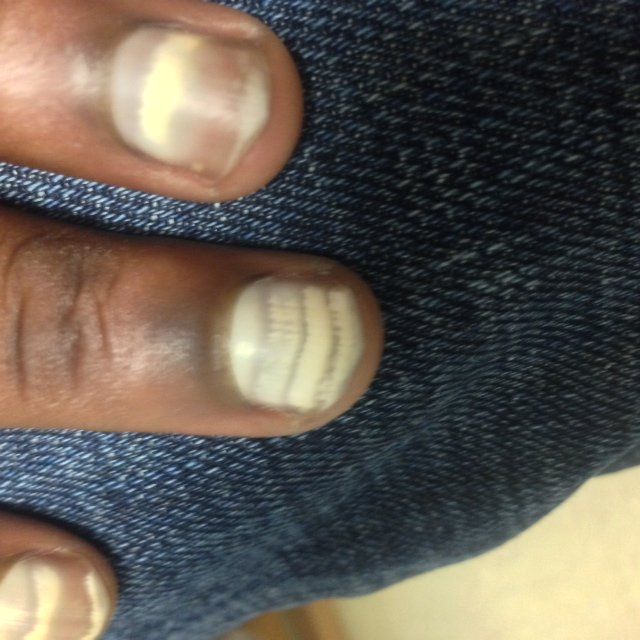- General Dermatology
- Eczema
- Chronic Hand Eczema
- Alopecia
- Aesthetics
- Vitiligo
- COVID-19
- Actinic Keratosis
- Precision Medicine and Biologics
- Rare Disease
- Wound Care
- Rosacea
- Psoriasis
- Psoriatic Arthritis
- Atopic Dermatitis
- Melasma
- NP and PA
- Skin Cancer
- Hidradenitis Suppurativa
- Drug Watch
- Pigmentary Disorders
- Acne
- Pediatric Dermatology
- Practice Management
- Prurigo Nodularis
Article
Nail discoloration could be a red flag
Careful examination of the nails recently helped reveal deliberate heavy metal poisoning in two murder cases, leading to the arrest of the perpetrators in two sordid who-done-it murder investigations.
Panama City, Panama - Careful examination of the

Leukonychia striata are transverse lines of discoloration that run parallel to the lunula in the nails of the fingers and toes. While they can appear after nail injury, in patients with renal failure, or those on chemotherapy, the appearance can also indicate heavy metal poisoning and should raise a red flag. (Photo: Carlton Ralph Daniel, III, M.D.) nails recently helped reveal deliberate heavy metal poisoning in two murder cases, leading to the arrest of the perpetrators in two sordid who-done-it murder investigations.
Certain cutaneous signs and symptoms occurring in the skin, hair and nails can be pathognomonic for certain disease processes in the body and can help clinicians home-in on a particular diagnosis or group of diseases such as the heliotrope sign and Gottron’s papules seen in patients with dermatomyositis, the Nikolsky’s sign in pemphigus patients, and the oil drop sign seen in psoriatic nails.
Similarly, Mees’ lines - also known as leukonychia striata - are transverse lines of discoloration that run parallel to the lunula in the nails of the fingers and toes. This nail sign can appear after an episode of poisoning with arsenic, thallium, lead or other heavy metals, although they can also occur after physical injury to the nails, or in patients with renal failure and those on chemotherapy.
Related: Forensic science lends a hand with detecting abuse
“Since its first mention in the literature, Mees’ lines have been associated with a number of systemic insults but classically, the discrete nail sign has been linked to heavy metal poisoning,” says Carlton Ralph Daniel III, M.D., department of dermatology, University of Mississippi Medical Center, Jackson, Miss. He spoke recently at the annual meeting of the North American Clinical Dermatologic Society.
“Today, however, we know that Mees’ line represents a reaction pattern and is not specifically pathognomonic for heavy metal poisoning. Nevertheless, their appearance does raise a red flag and can indicate a heavy metal poisoning in the affected patient,” he says.
Suspicion of poisoning
Dr. Daniel and his colleague Fred Bodie, M.D. from the University of Alabama, were asked to consult on a 16-year-old female patient who complained of weakness, weight loss, and drop foot of several months duration. After inspecting the nails and finding Mees’ lines, the physicians became suspicious of potential heavy metal poisoning. Upon analysis of the hair and nails, arsenic was found, confirming the diagnosis in the patient.
A criminal investigation ensued, and after looking at the family history, it was determined that the patient’s father had recently died. The body was exhumed and arsenic was found, as well. It was then discovered that the previous husband of the child’s mother had died in middle age. His body was also exhumed and it was found to have traces of arsenic. At that time, the mother of the child had mysteriously disappeared but was found a few years later, and was charged and convicted of murder and attempted murder.
In a similar murder investigation, arsenic was also found to be the cause of death, Dr. Daniel says. In this case, a 45-year-old traveling salesman was hospitalized several times with unexplained weakness and weight loss of over six months’ duration, without a diagnosis being found. Examination of the nails revealed Mees’ lines and subsequent analysis for heavy metal poisoning revealed arsenic.
At that point, the physician recalled a similar case where a 43-year-old traveling salesman who worked similar territories as the first traveling salesman had died of unexplained causes. The body was exhumed and arsenic was found. The ensuing criminal investigation revealed that both men regularly visited and ate at the same eatery and were served by the same waitress.
“Since fingernails grow at a rate of approximately 0.1 mm to 0.15 mm per day, a rough estimate of when the 45-year-old man was at that eatery was determined by measuring the distance between the Mees’ lines on his fingernails. Investigators found that the distance between the lines corresponded to his visits at the eatery. This information ultimately led to the arrest of the waitress who was convicted of murder,” Dr. Daniel says.
Related: Stem cells in nails give clues to limb regeneration
There is a long list of drugs, chemicals and biological substances that can accumulate and remain in hair and nails, where they can be detected and measured. According to Dr. Daniel, the nails are a particularly interesting substrate due to their slow growth rate, making them useful for retrospective analysis.
“The information ascertained from the analysis of the nails can prove to be very helpful in forensic science and can be useful in solving unexplained illnesses or deaths, as witnessed in these murder cases,” he says. “As clinicians, we should keep in mind that examination of the hair and nails is not optional but an important part of the clinical examination.”
Disclosures: Dr. Daniel reports no relevant financial interests.





